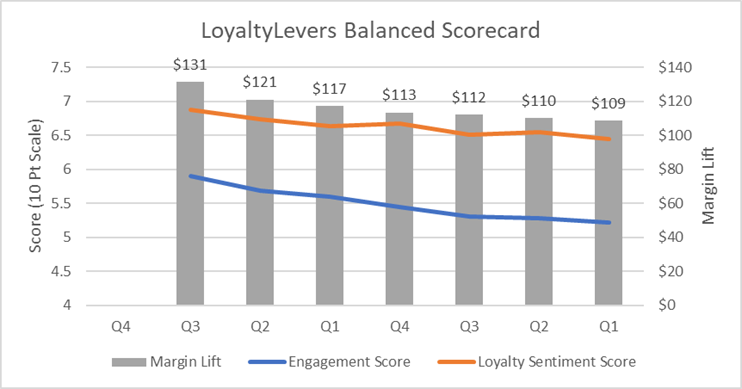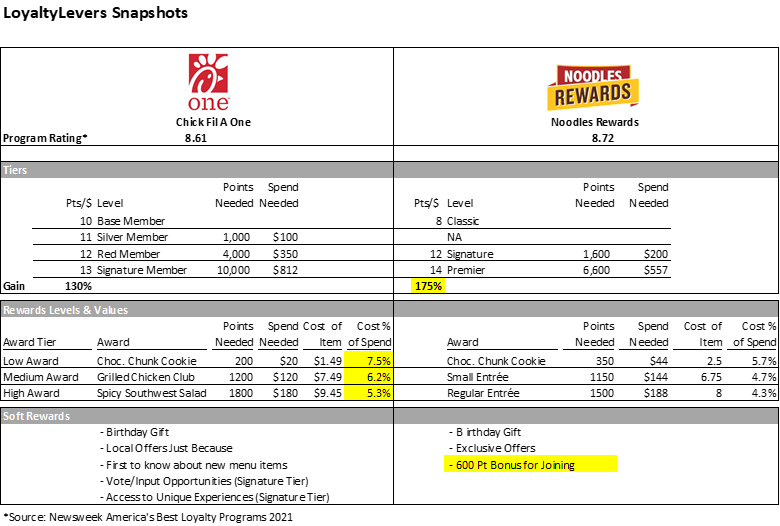LoyaltyLevers Balanced Scorecard: Measuring Behavior Changes
As noted in Loyalty Measurement: C-Suite Needs a Balanced Scorecard, executives need a balanced presentation of...
Often, the executive order comes down to launch a loyalty program, or perhaps overhaul the current one. It is a challenging assignment, because if you ask 10 people what makes an effective loyalty program, you’ll get as many different answers. For example, the CEO might be a frequent flyer and believe that it’s all about earning miles, while the CFO may be more in favor of a recognition program that doesn’t carry points liabilities. Meanwhile executives in operations could be more interested in a program that improves the customer experience and reduces strain on front line staff. So, what’s the right answer?!
LoyaltyLevers provides a balanced loyalty design framework, following our proven principles within a practical and flexible process that results in different/better loyalty program benefits. This article lays out the basics of design, process and loyalty KPI measurement, providing best in class examples along the way.
How to choose from the hundreds of loyalty program benefits options? In my experience evaluating 100’s of programs, and designing dozens, three focus areas consistently emerge. This is the foundation of the framework, which I have come to call LoyaltyLevers because little tweaks to each lever can result in big changes to loyalty. The three LoyaltyLevers are:
1. Behavior Drivers: Compelling new strategies to drive specific behaviors
2. Sentiment Builders: Forge a stronger emotional connection with your customer
3. Engagement Activators: Bring the benefits to life within the consumer experience.
These three levers are the heart of the program design process, which we’ll talk about more in a moment. But for now let’s get a bit deeper into each one of the Levers.
These are the rewards and incentives that pull customers to the next level of spend and lock them in. One key to success in this area is customer segmentation – identifying your high potential segments, reviewing their specific behavior patterns, and developing Behavior Drivers with that in mind. For example, if many of these customers seem to stall out at 2 visits per year, consider a generous threshold offer at 3 visits. If most customers join but never return or bother to use the card, consider a more immediate benefit. A comprehensive analysis of the member usage patterns spanning at least the last three years is an important foundation for real insights.
If you are starting from scratch, the decision on whether to offer points, free/discounted product, participate in a coalition program or nothing at all should be researched with the customers – again with a specific focus on the opportunity segments. Depending on the spend and frequency characteristics, different types of rewards will naturally make more sense. Beware of vendors selling canned solutions, they are by definition commodities and not differentiating.

For a full list of the Behavior Drivers, and an example of how Starbucks mastered this lever, please click here. Starbucks has taken a basic rewards concept (points towards free product) and made it highly impactful through targeting specific offers to each individual. Now the program accounts for more than half of their revenue.
Loyalty is not only a behavior, but a sentiment or emotion. To truly build loyalty, programs must build the loyalty sentiment. The most powerful programs tap into this Lever, with carefully curated benefits based on consumer insights.
To build loyalty sentiment, you need to find the intersection where your brand meets the consumer’s needs and create ideas around how the loyalty program can uniquely help improve the experience. There is an arsenal of field proven benefit areas including Status, Convenience/Control, Surprise & Delight, Personalization, Innovation, Lifestyle & Community, Purpose/Cause or Value. As part of the ideation process, it is important to develop a range of potential benefits, and then get consumer feedback via qualitative or quantitative research.

These interact with both of the other Levers, serving as a flywheel to improve impact even more. Simply creating a list of loyalty benefits is not enough, integration with the total brand experience in an engaging way activates the program.
Personalized and timely communications play a key role, far too many loyalty programs ignore the wealth of data at their fingertips and blast one size fits all messaging – and consumers instinctively block that out. Membership Lifecycle is a key component for all loyalty programs, guiding the member from onboarding all the way to advocacy or win-back if needed.
Mobile devices now provide a key enabler, with all of the on-the-go capabilities it offers to blend at home and in person experiences. Location intelligence is one of the top opportunities for loyalty programs, particularly as privacy laws now require explicit permission for this kind of tracking. The program must offer a benefit for this kind of data access, Sephora provides a great example of this.
 Effective Loyalty programs are designed to tap into each of these three LoyaltyLevers, and as a result they drive incremental profit and build loyalty that lasts.
Effective Loyalty programs are designed to tap into each of these three LoyaltyLevers, and as a result they drive incremental profit and build loyalty that lasts.
A comprehensive design process that covers all of these bases does take some time. Done well, the design process will span 3 – 6 months and include stakeholder interviews, data analysis, ideation, market research, prototyping or service visualizations, and of course financial modeling. Once a concept is selected, Loyalty Program Implementation planning will kick into gear, in preparation for a successful launch.
Building on established Design Thinking processes, the LoyaltyLevers Pathway includes these main elements.

The LoyaltyLevers Pathway must begin with the end in mind – improvement. No CFO ever approved a program based on maintaining the status quo, so be sure that your measurement is focused on lift.
The other key consideration is to get a balanced view of the program impact. Are you changing attitudes? Increasing profit? Creating more engagement with the brand? Having a read on all three of these will allow you to triangulate on the program impact. For more information on the LoyaltyLevers Balanced Scorecard approach to loyalty KPI’s, please click here.
It can be useful to compare and contrast different programs in an attempt to see some of the design principles in action. In a recent survey from Newsweek, Noodles Rewards edged out much larger brand Chick Fil A with a higher rating. This despite the fervent brand loyalty of Chick Fil A customers, and a richer rewards earn out schedule! For example, Chick Fil A members receive up to 7.5% back on their spend, whereas Noodles Rewards is less than 6%.
However, Noodles Rewards did two important things that really set it apart. Firstly, they provided an immediate benefit just for joining. This gives the member an immediate sense of gratification that Chick Fil A lacks. Secondly, they give much greater point bonuses to members based on how much they spend, so for those customers, the pay back on the loyalty program is actually higher than Chik Fil A.
Seemingly small changes, yet they had a big impact for Noodles & Company. It’s worth mentioning that neither program has much in the way of tangible sentiment builders. Chick Fil A touts “unique experiences” and “Voting/Input Opportunities”, but there is little evidence these play a big role in the program. I would question whether either of these programs is building much positive loyalty Sentiment

While the precise answer to the question “What the design characteristics of an effective loyalty program?” will vary from brand to brand, there are proven design principles that you can leverage to take a rich, multi-pronged approach. Following it will put you miles ahead of the rest of the pack, where the norm is to make minor tweaks to a cookie cutter approach and roll it out.
As noted in Loyalty Measurement: C-Suite Needs a Balanced Scorecard, executives need a balanced presentation of...
Have no doubt, this is a moment of opportunity for loyalty programs. Data privacy laws continue to tighten, which...
Comments